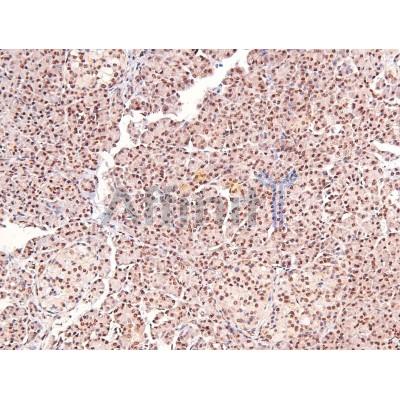Phospho-CUTL1 (Ser1215) Antibody - #AF8262
| Product: | Phospho-CUTL1 (Ser1215) Antibody |
| Catalog: | AF8262 |
| Description: | Rabbit polyclonal antibody to Phospho-CUTL1 (Ser1215) |
| Application: | WB IHC |
| Reactivity: | Human, Mouse, Rat, Monkey |
| Prediction: | Pig, Sheep, Dog, Xenopus |
| Mol.Wt.: | 120kD,160kD,200kD; 164kD(Calculated). |
| Uniprot: | P39880 |
| RRID: | AB_2840324 |
Related Downloads
Protocols
Product Info
*The optimal dilutions should be determined by the end user. For optimal experimental results, antibody reuse is not recommended.
*Tips:
WB: For western blot detection of denatured protein samples. IHC: For immunohistochemical detection of paraffin sections (IHC-p) or frozen sections (IHC-f) of tissue samples. IF/ICC: For immunofluorescence detection of cell samples. ELISA(peptide): For ELISA detection of antigenic peptide.
Cite Format: Affinity Biosciences Cat# AF8262, RRID:AB_2840324.
Fold/Unfold
CASP; CCAAT displacement protein; CDP; CDP/Cut; CDP1; Clox; COY1; Cut homeobox; Cut homolog; Cut like 1; Cut like homeobox 1; CUTL1; CUX; Cux/CDP; CUX1; Golgi integral membrane protein 6; GOLIM6; Homeobox protein cux 1; Nbla10317; p100; p110; p200; p75; Protein CASP; Putative protein product of Nbla10317;
Immunogens
A synthesized peptide derived from human CUTL1 around the phosphorylation site of Ser1215.
- P39880 CUX1_HUMAN:
- Protein BLAST With
- NCBI/
- ExPASy/
- Uniprot
MLCVAGARLKRELDATATVLANRQDESEQSRKRLIEQSREFKKNTPEDLRKQVAPLLKSFQGEIDALSKRSKEAEAAFLNVYKRLIDVPDPVPALDLGQQLQLKVQRLHDIETENQKLRETLEEYNKEFAEVKNQEVTIKALKEKIREYEQTLKNQAETIALEKEQKLQNDFAEKERKLQETQMSTTSKLEEAEHKVQSLQTALEKTRTELFDLKTKYDEETTAKADEIEMIMTDLERANQRAEVAQREAETLREQLSSANHSLQLASQIQKAPDVEQAIEVLTRSSLEVELAAKEREIAQLVEDVQRLQASLTKLRENSASQISQLEQQLSAKNSTLKQLEEKLKGQADYEEVKKELNILKSMEFAPSEGAGTQDAAKPLEVLLLEKNRSLQSENAALRISNSDLSGSARRKGKDQPESRRPGSLPAPPPSQLPRNPGEQASNTNGTHQFSPAGLSQDFFSSSLASPSLPLASTGKFALNSLLQRQLMQSFYSKAMQEAGSTSMIFSTGPYSTNSISSQSPLQQSPDVNGMAPSPSQSESAGSVSEGEEMDTAEIARQVKEQLIKHNIGQRIFGHYVLGLSQGSVSEILARPKPWNKLTVRGKEPFHKMKQFLSDEQNILALRSIQGRQRENPGQSLNRLFQEVPKRRNGSEGNITTRIRASETGSDEAIKSILEQAKRELQVQKTAEPAQPSSASGSGNSDDAIRSILQQARREMEAQQAALDPALKQAPLSQSDITILTPKLLSTSPMPTVSSYPPLAISLKKPSAAPEAGASALPNPPALKKEAQDAPGLDPQGAADCAQGVLRQVKNEVGRSGAWKDHWWSAVQPERRNAASSEEAKAEETGGGKEKGSGGSGGGSQPRAERSQLQGPSSSEYWKEWPSAESPYSQSSELSLTGASRSETPQNSPLPSSPIVPMSKPTKPSVPPLTPEQYEVYMYQEVDTIELTRQVKEKLAKNGICQRIFGEKVLGLSQGSVSDMLSRPKPWSKLTQKGREPFIRMQLWLNGELGQGVLPVQGQQQGPVLHSVTSLQDPLQQGCVSSESTPKTSASCSPAPESPMSSSESVKSLTELVQQPCPPIEASKDSKPPEPSDPPASDSQPTTPLPLSGHSALSIQELVAMSPELDTYGITKRVKEVLTDNNLGQRLFGETILGLTQGSVSDLLARPKPWHKLSLKGREPFVRMQLWLNDPNNVEKLMDMKRMEKKAYMKRRHSSVSDSQPCEPPSVGTEYSQGASPQPQHQLKKPRVVLAPEEKEALKRAYQQKPYPSPKTIEDLATQLNLKTSTVINWFHNYRSRIRRELFIEEIQAGSQGQAGASDSPSARSGRAAPSSEGDSCDGVEATEGPGSADTEEPKSQGEAEREEVPRPAEQTEPPPSGTPGPDDARDDDHEGGPVEGPGPLPSPASATATAAPAAPEDAATSAAAAPGEGPAAPSSAPPPSNSSSSSAPRRPSSLQSLFGLPEAAGARDSRDNPLRKKKAANLNSIIHRLEKAASREEPIEWEF
Predictions
Score>80(red) has high confidence and is suggested to be used for WB detection. *The prediction model is mainly based on the alignment of immunogen sequences, the results are for reference only, not as the basis of quality assurance.
High(score>80) Medium(80>score>50) Low(score<50) No confidence
Research Backgrounds
Transcription factor involved in the control of neuronal differentiation in the brain. Regulates dendrite development and branching, and dendritic spine formation in cortical layers II-III. Also involved in the control of synaptogenesis. In addition, it has probably a broad role in mammalian development as a repressor of developmentally regulated gene expression. May act by preventing binding of positively-activing CCAAT factors to promoters. Component of nf-munr repressor; binds to the matrix attachment regions (MARs) (5' and 3') of the immunoglobulin heavy chain enhancer. Represses T-cell receptor (TCR) beta enhancer function by binding to MARbeta, an ATC-rich DNA sequence located upstream of the TCR beta enhancer. Binds to the TH enhancer; may require the basic helix-loop-helix protein TCF4 as a coactivator.
Nucleus.
Belongs to the CUT homeobox family.
Restrictive clause
Affinity Biosciences tests all products strictly. Citations are provided as a resource for additional applications that have not been validated by Affinity Biosciences. Please choose the appropriate format for each application and consult Materials and Methods sections for additional details about the use of any product in these publications.
For Research Use Only.
Not for use in diagnostic or therapeutic procedures. Not for resale. Not for distribution without written consent. Affinity Biosciences will not be held responsible for patent infringement or other violations that may occur with the use of our products. Affinity Biosciences, Affinity Biosciences Logo and all other trademarks are the property of Affinity Biosciences LTD.




